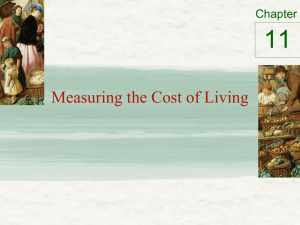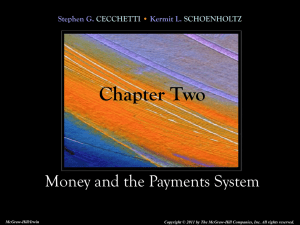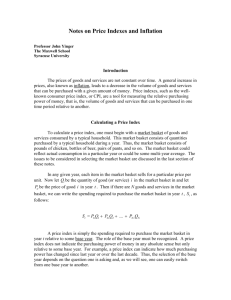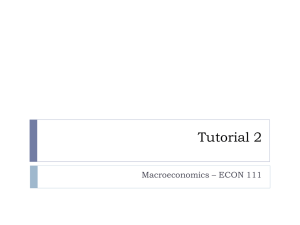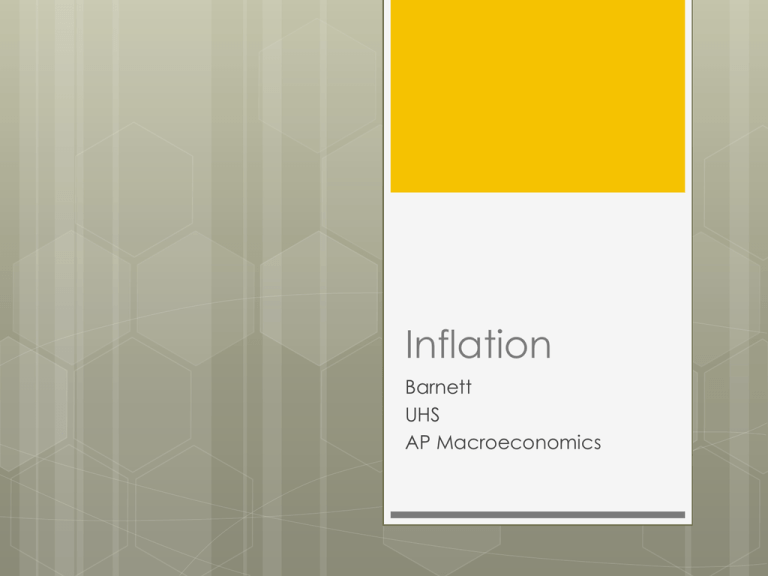
Inflation
Barnett
UHS
AP Macroeconomics
Definitions
Price
Level – Average price of all goods and
services in an economy at a specific time.
Inflation
- the rate that the Price Level (average
prices) rises
Anticipated vs Unanticipated
Most
people expect a 2% - 4% inflation rate
We
are mostly concerned with unexpected
inflation
What does money decreasing in purchasing power
mean for you?
Creates winners and losers
Anticipated vs Unanticipated
Winners
Holders of assets that rise in value faster than other
assets rise in value
Like
Gold
Treasury Bonds
Anticipated vs Unanticipated
Winners
Debtors
Repay
creditors with dollars worth less than the ones
they received or used
Anticipated vs Unanticipated
Winners
Government – Taxes
Unanticipated
inflation causes nominal wages to
increase
Causes people to go into higher tax brackets – owe
more money in taxes (state)
Anticipated vs Unanticipated
Losers
Savers at a fixed rate
Anticipated vs Unanticipated
Losers
Individuals living on a fixed income
Social
Security before 1975
Now receive Cost of Living Adjustment (COLA)
Creditors
Banks
– Make loan at 6% (nominal – what you see) and
inflation is at 4% = 2% real rate of return
But…if inflation goes up to 6% = 0% real rate of return
Anticipated vs Unanticipated
General
Rule of thumb
When there is rapid inflation people want to get out
of money savings and invest in something real –
tangible
1972
inflation – 3.3%
1973 inflation – 6.3%
1974 inflation – 11%
Demand Pull vs Cost Push
Consumer Price Index
CPI:
measure of the average change over time in
the prices paid by urban consumers for a market
basket of consumer goods and services
Reveals price level
Helps determine inflation rate
Not included: People living in rural areas, Armed
Forces, people in asylums and prisons
Compile information from selected families who are
interviewed and keep diaries listing purchases
Consumer Price Index
200 categories of goods - sorted in 8 major groups
FOOD AND BEVERAGES (breakfast cereal, milk, coffee, chicken,
wine, full service meals, snacks)
HOUSING (rent of primary residence, owners' equivalent rent,
fuel oil, bedroom furniture)
APPAREL (men's shirts and sweaters, women's dresses, jewelry)
TRANSPORTATION (new vehicles, airline fares, gasoline, motor
vehicle insurance)
MEDICAL CARE (prescription drugs and medical supplies,
physicians' services, eyeglasses and eye care, hospital services)
RECREATION (televisions, toys, pets and pet products, sports
equipment, admissions);
EDUCATION AND COMMUNICATION (college tuition, postage,
telephone services, computer software and accessories);
OTHER GOODS AND SERVICES (tobacco and smoking products,
haircuts and other personal services, funeral expenses).
What’s in the CPI’s Basket?
4% 3%
Housing
6%
Transportation
6%
Food & Beverages
43%
6%
Medical care
Recreation
Education and
communication
Apparel
15%
17%
Other
How the CPI Is Calculated
1. Fix the “basket.”
The Bureau of Labor Statistics (BLS) surveys
consumers to determine what’s in the typical
consumer’s “shopping basket.”
2. Find the prices.
The BLS collects data on the prices of all the
goods in the basket.
3. Compute the basket’s cost.
Use the prices to compute the total cost of the
basket.
4. Choose a base year and compute the index.
The CPI in any year equals
How the CPI Is Calculated
100 x
cost of basket in current year
cost of basket in base year
5. Compute the inflation rate.
The percentage change in the CPI from
the preceding period.
Inflation
=
rate
CPI this year – CPI last year
CPI last year
x 100%
CPI
CPI Shortcomings
Substitution
Bias
Introduction of New Goods
Unmeasured Quality Changes
All
increase the value of a dollar & overstate
increases in cost of living
Best Measure of Inflation?
CPI:
Measures inflation as experienced by
consumers in their day-to-day life
PPI: Market basket of producer goods
GDP Deflator: Measures inflation experienced by
consumers, government and entities supplying
goods to consumers.
Contrasting the CPI and GDP Deflator
Imported consumer goods:
included in CPI
excluded from GDP deflator
Capital goods:
excluded from CPI
included in GDP
The basket:
deflator (if produced
CPI uses fixed basket
domestically)
GDP deflator uses basket of
currently produced goods &
services
This matters if different prices are
changing by different amounts.
ACTIVE LEARNING
3
CPI vs. GDP deflator
In each scenario, determine the effects on the
CPI and the GDP deflator.
A. Starbucks raises the price of Frappuccinos.
B. Caterpillar raises the price of the industrial
tractors it manufactures at its Illinois
factory.
C. Armani raises the price of the Italian jeans
it sells in the U.S.
© 2012 Cengage Learning. All Rights Reserved. May not be copied, scanned, or duplicated, in whole or in part, except for use as
permitted in a license distributed with a certain product or service or otherwise on a password-protected website for classroom use.
ACTIVE LEARNING
Answers
3
A. Starbucks raises the price of Frappuccinos.
The CPI and GDP deflator both rise.
B. Caterpillar raises the price of the industrial tractors
it manufactures at its Illinois factory.
The GDP deflator rises, the CPI does not.
C. Armani raises the price of the Italian jeans it sells in
the U.S.
The CPI rises, the GDP deflator does not.
© 2012 Cengage Learning. All Rights Reserved. May not be copied, scanned, or duplicated, in whole or in part, except for use as
permitted in a license distributed with a certain product or service or otherwise on a password-protected website for classroom use.
Correcting Variables for Inflation: Indexation
A dollar amount is indexed for inflation
if it is automatically corrected for inflation
by law or in a contract.
For example, the increase in the CPI automatically
determines
the
COLA in many multi-year labor
contracts
adjustments
in Social Security payments
and federal income tax brackets
Correcting Variables for Inflation:
Real vs. Nominal Interest Rates
The nominal interest rate:
the interest rate not corrected for inflation
the rate of growth in the dollar value of a
deposit or debt
The real interest rate:
corrected for inflation
the rate of growth in the purchasing power of a deposit
or debt
Real interest rate
= (nominal interest rate) – (inflation rate)
Correcting Variables for Inflation:
Real vs. Nominal Interest Rates
Example:
Deposit $1,000 for one year.
Nominal interest rate is 9%.
During that year, inflation is 3.5%.
Real interest rate
= Nominal interest rate – Inflation
= 9.0% – 3.5% = 5.5%
The purchasing power of the $1000 deposit
has grown 5.5%.
Real and Nominal Interest Rates in the U.S.,
1950–2010


